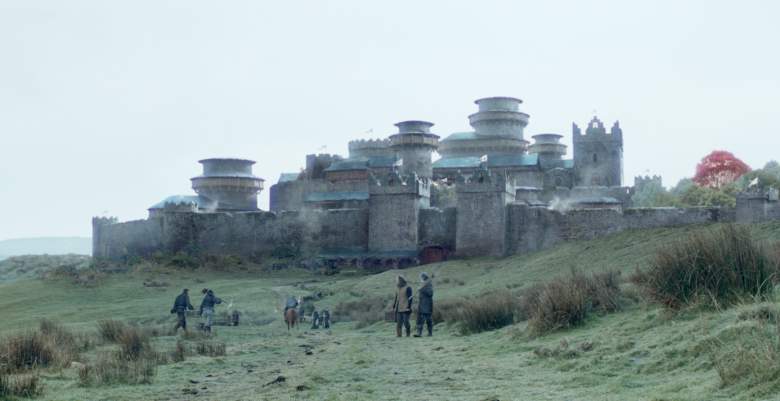
What is hidden in the mysterious crypts of Winterfell? (HBO)
Winterfell is the ancient castle of House Stark and it is a massive place. For thousands of years the Starks weren’t just northern Lords, they were kings ruling over a vast kingdom. So it makes sense that their family stronghold would be impressive. Winterfell is shrouded in mystery, but no part of Winterfell is more mysterious than the crypts. An astounding amount of the narrative in A Song of Ice and Fire, the Game of Thrones book series, is dedicated to to this vast underground labyrinth, and George R. R. Martin hasn’t yet revealed why. (NOTE: This story was originally written in 2016, but the theory is getting renewed interest following the final season trailer that HBO just released. The story has been updated with details about the new trailer at the end.)
We’ve been mulling this over for a while now, reading theories and watching videos, trying to get to the bottom of it. And we’ve come across some really interesting ideas. Some people think Rhaegar’s harp is in the crypts and it will somehow prove that Jon is a Targaryen. Some people think there’s a dragon hidden there. And some people think it holds a special sword.
While there’s a lot of debate, most fans agree that the crypts hold something far more interesting than a few dead Starks. So what’s down there?
Well, our favorite theory is that the crypts are a prison, built to contain a powerful and malevolent evil: the Great Other.
Here’s what you need to know.
SPOILER WARNING
Cryptic Sayings of the North
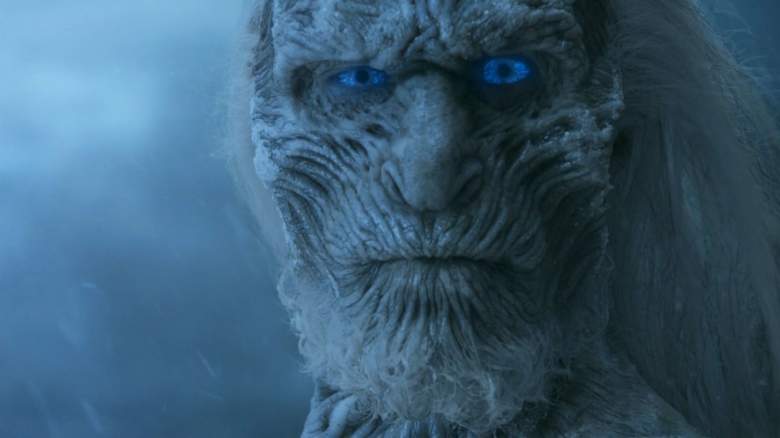
Do the crypts of Winterfell hide a dark secret? (HBO)
George R. R. Martin has left a lot of unanswered questions about the Starks and Winterfell, and a great many of them have to do with common sayings. Major characters keep saying them, and we’re just left to guess about their origin and meaning. It’s kind of like a puzzle that Martin is daring us to solve. Statements like “Winter is coming,” “the North remembers,” and “there must always be a Stark in Winterfell” have given rise to dozens of fan theories over the years.
These sayings take on a life of their own, though, if you assume that Winterfell was built to imprison the Great Other. For argument’s sake, let’s assume it is. And we’re also going to assume that “Winter” is just another way of referring to the Great Other.
Winterfell
We’re never told why the Stark’s castle is called Winterfell. Places like Storms End, the Red Keep, Harrenhall, the Tower of the Hand, Kings Landing – we know why they were named what they were. So why no explanation for Winterfell? It would make sense, though, if the God of Winter literally fell from power there. The name of the castle is a reminder of the fact that the Long Night is over and Winter has fallen. It might also mark the exact spot where Winter fell.
The Kings of Winter
We’re never told why the Starks are called the Kings of Winter, but it would make sense if the Starks essentially hold power over the God of Winter aka the Great Other. If you ruled over Ireland, you might be called the King of the Irish. If you rule over Winter, you might be called the King of Winter.
Winter Is Coming

Jon’s nemesis. (HBO)
All Kings and Queens worry about being deposed. It’s just part of the job description. One great way to maintain power in a monarchy is to remind people how bad it might be if you weren’t in charge. So why should you bow the knee and be a good servant to the Starks? Because Winter is coming. And you’d much rather deal with the Starks than with Winter.
The North Remembers
Imprisoned gods don’t die of old age. They stay locked up until someone sets them free. And that’s why “The North Remembers” is such an oft-repeated phrase. You might have thought the saying rose up as a rallying cry against the Freys after the Red Wedding, but a careful reading shows that this saying actually predates the Red Wedding, as shown in A Storm of Swords, Catelyn III:
Robb shook his head. ‘Even if Harrion were that sort, he could never openly forgive his father’s killer. His own men would turn on him. These are northmen, Uncle. The north remembers.'”
There Must Always Be a Stark in Winterfell
We’re told several times that “there must always be a Stark in Winterfell,” but no one ever tells us why. Just see these examples from A Game of Thrones, Catelyn II and Catelyn III:
‘Yes,’ Ned said, in words that would brook no argument. ‘You must govern the north in my stead, while I run Robert’s errands. There must always be a Stark in Winterfell.'”
‘I’ll go,’ Robb said. ‘
No,’ she told him. ‘Your place is here. There must always be a Stark in Winterfell.'”
Maybe it’s just good strategy to deter rival Lords from rising in rebellion. But when we first hear Ned say this, he’s a northern Lord presiding over a peaceful region. His bannermen are loyal, and there’s not even a whiff of rebellion in the air. It seems silly that he would be worrying about that. Consider that when these words are spoken, Robert had just gone on an extended vacation from King’s Landing and taken his entire family with him.
But what if there’s more to it? We’re not given a lot of details for this, but it may have to do with the enchantment that holds the Great Other within his prison. We know the Starks are blood descendants of Bran the Builder, and blood magic is the strongest kind of magic. So it’s a reach, but perhaps the mere presence of a Stark is required to maintain the bonds that keep Winter from escaping.
The Winterfell Crypts Would Make a Good Prison for the Great Other
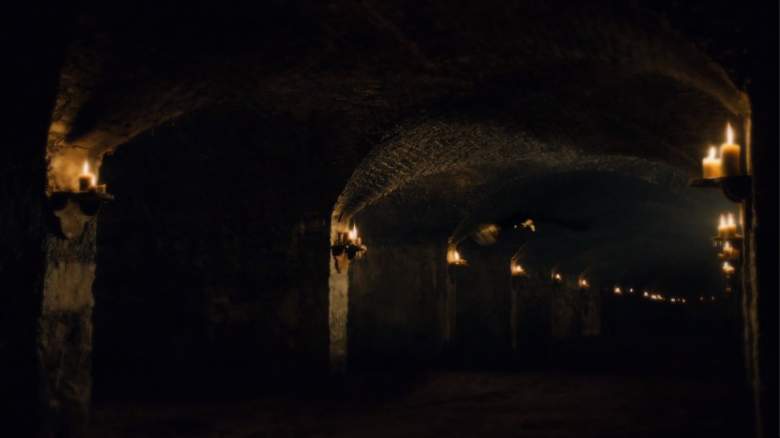
The Winterfell crypts. (HBO)
The crypts of Winterfell are enormous. This quote from A Dance with Dragons, The Turncloak, illustrates that point:
‘There are lower levels. Older. The lowest level is partly collapsed, I hear. I have never been down there.’ He pushed the door open and led them out into a long vaulted tunnel, where mighty granite pillars marched two by two into blackness.”
The crypts are built below the oldest building in Winterfell: the First Keep, as described in A Dance with Dragons and The World of Ice and Fire.
The entrance to the crypts was in the oldest section of the castle, near the foot of the First Keep, which had sat unused for hundreds of years.” (A Dance with Dragons)
Within its walls, the castle sprawls across several acres of land, encompassing many freestanding buildings. The oldest of these—a long-abandoned tower, round and squat and covered with gargoyles—has become known as the First Keep.” (The World of Ice and Fire)
The First Keep was built by a famous figure in the history of Westeros: Bran the Builder. He raised both Winterfell and the Wall thousands of years ago. Bran the Builder is also known to have built other famous, and still standing, structures. He built the incredibly high tower in Oldtown, as explained in The World of Ice and Fire:
That tower, we are told, rose two hundred feet above the harbor. Some say it was designed by Brandon the Builder…”
He helped build Storms End, a castle famously known to be god-proof. This is explained in The World of Ice and Fire: The Stormlands:
…In their wroth, they (the gods) sent howling winds and lashing rains to knock down every castle Durran dared to build, until a young boy helped him erect one so strong and cunningly made that it could defy their gales. The boy grew to be Brandon the Builder; Durran became the first Storm King. With Elenei at his side, he lived and reigned at Storm’s End for a thousand years, or so the stories claim.”
Bran also knew how to build using magic, according to A Clash of Kings, Catelyn III:
A seventh castle he raised, most massive of all. Some said the children of the forest helped him build it, shaping the stones with magic; others claimed that a small boy told him what he must do, a boy who would grow to be Bran the Builder.”
And, most importantly, he built the Wall, according to A Storm of Swords, Samwell V:
Maester Aemon, calm as always, said, “Your Grace, the Night’s Watch has been choosing its own leader since Brandon the Builder raised the Wall.”
Winterfell Doesn’t Seem as Special as Bran’s Other Works
Each of these structures are amazing in some way. But Winterfell, by comparison, just doesn’t seem that special.
For starters, it’s not really that big, as described in Martin’s books:
That brought you up to the blind side of the First Keep, the oldest part of the castle, a squat round fortress that was taller than it looked.” (A Game of Thrones – Bran II)
The First Keep was simple enough, an old round drum tower, but Sansa was stymied again when it came to putting the gargoyles around the top.” (A Storm of Swords – Sansa VII)
And it doesn’t seem to be a part of some grand design either.
The castle itself is peculiar in that the Starks did not level the ground when laying down the foundations and walls of the castle. Very likely, this reveals that the castle was built in pieces over the years rather than being planned as a single structure. Some scholars suspect that it was once a complex of linked ringforts, though the centuries have eradicated almost all evidence of this.” (The World of Ice and Fire – Winterfell)
Nevertheless, Bran the Builder had to enlist the help of giants to build it, as Martin describes in A Storm of Swords, Jon V:
In legend, Brandon the Builder had used giants to help raise Winterfell, but Jon did not want to confuse the issue.”
Winterfell Was Built Right After the Others Were Defeated
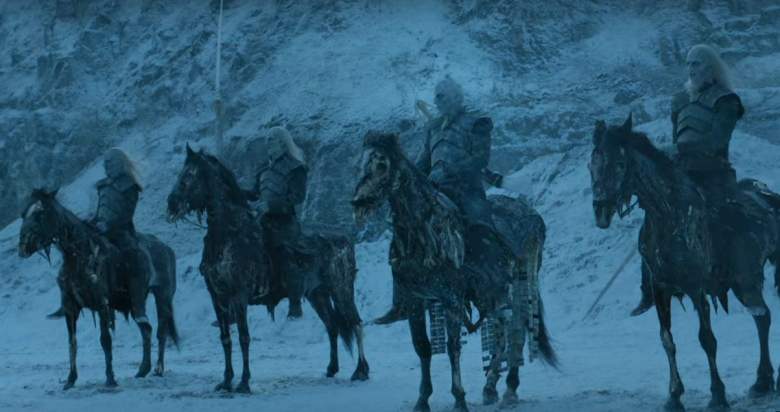
Winterfell was built after the Others were defeated. (HBO)
Bran did all of this right after the Long Night. In other words, just after the Others were defeated, according to The World of Ice and Fire, Winterfell:
Legend says that Brandon the Builder raised Winterfell after the generation-long winter known as the Long Night…”
So maybe Bran the Builder wasn’t planning the mighty castle that Winterfell would become. Maybe, instead, he was building a subterranean prison. If so, the First Keep just seems unimpressive because the bulk of his labor took place underground — an idea that is supported by this quote from A Game of Thrones, Bran VII:
The vault was cavernous, longer than Winterfell itself, and Jon had told him once that there were other levels underneath, vaults even deeper and darker where the older kings were buried.”
Winterfell has another interesting feature. It was built directly over a geological marvel: hot springs. This quote from A Game of Thrones, Catelyn II, explains it:
The castle had been built over natural hot springs, and the scalding waters rushed through its walls and chambers like blood through a man’s body, driving the chill from the stone halls, filling the glass gardens with a moist warmth, keeping the earth from freezing. Open pools smoked day and night in a dozen small courtyards. That was a little thing, in summer; in winter, it was the difference between life and death.”
Now it’s possible that these hot springs aren’t just a natural occurrence. There is a rumor among the locals of Winterfell that a dragon lives under the castle, causing the hot springs.
Yet the smallfolk of Winterfell and the winter town have been known to claim that the springs are heated by the breath of a dragon that sleeps beneath the castle.” (The World of Ice and Fire – Winterfell)
That sounds crazy, we know. But there is a surprising amount of evidence to support this theory. We’ve laid it all out in our article: Is a Dragon in the Winterfell Crypts on ‘Game of Thrones’?
So let’s review. Winterfell began as the First Keep, which despite appearing mundane, required the skill of Bran the Builder and giants to construct. The First Keep has an enormous crypt buried deep beneath it, and it was specifically built over hot springs. Its construction occurred just after the Long Night ended and the Others were defeated.
Hmmm…Underground caverns surrounded by heat. Sounds like the logical place to imprison a god of ice magic, right?

The hot-spring-fueled Winterfell crypts could be perfect for an ice god. (HBO)
So what else are we told about the crypts?
Despite all the geological warmth coming from underground, it’s still a very cold place. Mostly. This is explained in A Dance with Dragons, The Turncloak:
The way was narrow and steep, the steps worn in the center by centuries of feet. They went single file—the serjeant with the lantern, then Theon and Lady Dustin, her other man behind them. He had always thought of the crypts as cold, and so they seemed in summer, but now as they descended the air grew warmer. Not warm, never warm, but warmer than above. Down there below the earth, it would seem, the chill was constant, unchanging.”
This is further highlighted in A Game of Thrones, Eddard I:
He led the way between the pillars and Robert followed wordlessly, shivering in the subterranean chill. It was always cold down here.”
Strange Traditions Surround the Winterfell Crypts

The crypts of Winterfell have many strange traditions. (HBO)
There are also some strange traditions surrounding the Winterfell crypts, and they are taken very seriously.
For one, all the dead Stark kings who are buried there have statues. Each of these statues have stone direwolves at their feet and an iron sword across their laps. Only the Lords of Winterfell have statues in the Winterfell crypts, except Brandon and Lyanna, Ned’s brother and sister, which is a major break from tradition:
His daughter Lyanna and his son Brandon are in the tombs beside him. Not me, another Brandon, my father’s brother. They’re not supposed to have statues, that’s only for the lords and the kings, but my father loved them so much he had them done.”
A Game of Thrones – Bran VII
This is explained more in A Game of Thrones, Eddard I:
The Lords of Winterfell watched them pass. Their likenesses were carved into the stones that sealed the tombs. In long rows they sat, blind eyes staring out into eternal darkness, while great stone direwolves curled round their feet. The shifting shadows made the stone figures seem to stir as the living passed by.
By ancient custom an iron longsword had been laid across the lap of each who had been Lord of Winterfell, to keep the vengeful spirits in their crypts…”
As you can see in the above quote, the Ned seem to think the iron sword is meant to keep the vengeful spirits in their crypts. Ned isn’t the only one concerned about this. Theon also believes it in A Dance With Dragons, A Ghost in Winterfell:
He was trapped here, with the ghosts. The old ghosts from the crypts and the younger ones that he had made himself… My work. My ghosts. They are all here, and they are angry. He thought of the crypts and those missing swords.”
Strange Dreams About the Winterfell Crypts

Theon did not like the idea of souls of those he maimed watching him in the crypts. (HBO)
One final bit of evidence is that Jon has strange dreams about the crypts. (As do Ned, Bran, and Rickon, btw.) This is explained thoroughly when Sam and Jon talk in A Game of Thrones, Jon IV.
And then I find myself in front of the door to the crypts. … Somehow I know I have to go down there, but I don’t want to. I’m afraid of what might be waiting for me. The old Kings of Winter are down there, sitting on their thrones with stone wolves at their feet and iron swords across their laps, but it’s not them I’m afraid of. I scream that I’m not a Stark, that this isn’t my place, but it’s no good, I have to go anyway… It gets darker and darker, until I want to scream.”
Jon has many dreams of Winterfell’s crypts that are discussed in the books. In A Game of Thrones, Jon VII, he dreams of going deeper into the crypts than ever before:
When he turned he saw that the vaults were opening, one after the other. As the dead kings came stumbling from their cold black graves, Jon had woken in pitch-dark, his heart hammering. Even when Ghost leapt up on the bed to nuzzle at his face, he could not shake his deep sense of terror… It was only a dream. I am a brother of the Night’s Watch now, not a frightened boy.”
And in A Storm of Swords, Jon VIII, he’s still dreaming of those crypts:
He dreamt he was back in Winterfell, limping past the stone kings on their thrones. … You are no Stark, he could hear them mutter, in heavy granite voices. There is no place for you here. Go away…”
After a while, the dreams of crypts began to haunt him in A Storm of Swords, Samwell IV:
“I don’t even dream of Ghost anymore. All my dreams are of the crypts, of the stone kings on their thrones. Sometimes I hear Robb’s voice, and my father’s, as if they were at a feast. But there’s a wall between us, and I know that no place has been set for me.”
Concluding the Mystery of the Crypts
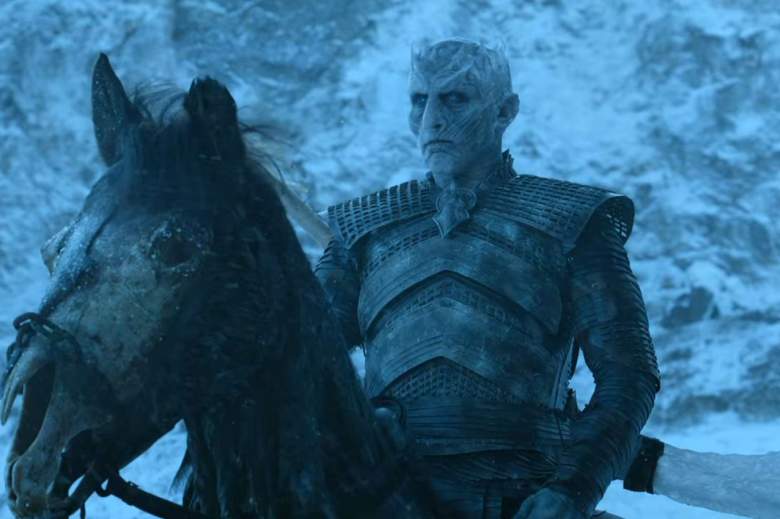
The mystery of the Winterfell crypts runs deep. (HBO)
In conclusion, the Winterfell crypts are ancient, constantly mentioned throughout the books, and they are surrounded by mystery. The lowest level is collapsed, barring entry, and Jon is scared of something in there that isn’t the dead Kings of Winter. It feels like GRRM is setting us up for a big reveal about those crypts. And our guess is that the crypts are a prison for the Great Other.
If it is, then maybe Hodor, when he was a boy, got lost in the crypts and found himself face to face with the Great Other.
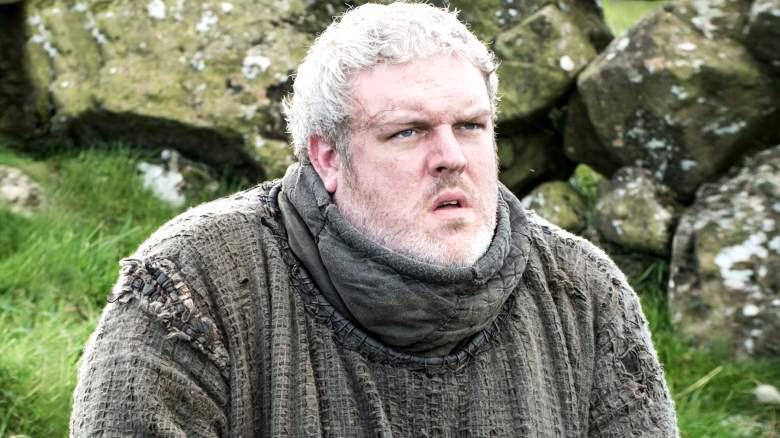
What did Hodor see in the crypts? (HBO)
(Note: Before the big Hodor reveal, we had theorized that perhaps seeing the Great Other was why he only said Hodor. Although that theory was not correct, it doesn’t make the crypts of Winterfell any less mysterious or compelling.)
The Crypts Are Featured in the Game of Thrones Final Season 8 Trailer
The crypts are getting renewed interest, thanks to their appearance in the new Game of Thrones Season 8 trailer.
Arya appears to be running from something in the crypts, and we see characters hiding there. One theory is that dead Starks will rise in the crypts this season. The dormant dragon theory, mentioned earlier in this story, or the Great Other theory could also finally come into play this season.